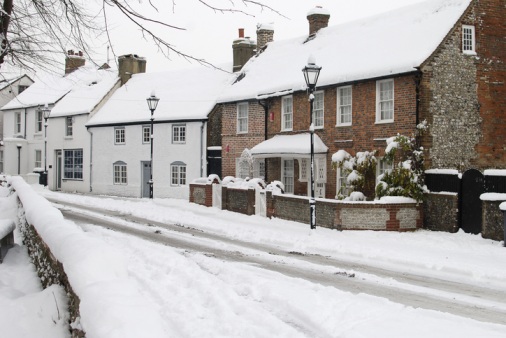How to protect your property from the big winter freeze

By QBE Senior Risk Manager Steve Cheung
Weather forecasters are warning that UK temperatures may plunge over the next couple of weeks, with a chance of a white Christmas. Freezing temperatures, ice and snow can take a huge toll on every aspect of domestic and business life. In a typical winter the Association of British Insurers (ABI) estimates frozen and burst water pipes cost £7 million daily to UK businesses and householders. In 2010 the UK ‘big freeze’ resulted in costs exceeding £1 billion for clean-up and repair.
Much of the property damage that occurs as a result of freezing conditions is from water damage following the thaw. And as many people know from personal experience, once a building gets wet on the inside it is difficult to restore and recover.
Prior preparation
As winter weather approaches, conditions can change quickly. Disruption to public transport, roads, power supplies, and other key services can throw plans off track so there’s a need to be ready to cater for the unexpected. If possible, it’s recommended to prepare a winter freeze prevention plan and to circulate copies to everyone involved. This can include:
- Ensuring any emergency materials such as salt, grit, sandbags, fuel, antifreeze, tarpaulins are made ready, as well as emergency tools such as snow shovels, buckets, cold weather clothing and boots.
- Checking tools and equipment for emergency isolation and drain down of tanks, boilers, water pipes and sprinklers.
- Knowing how to thaw frozen pipes safely should they occur.
It’s important that everyone is prepared and remains vigilant. Seemingly innocuous actions can have significant effects during cold weather.
- A normally closed door that’s left open can cause pipes to freeze
- Using a blow torch to thaw frozen pipes can cause the building to catch fire
- Lack of basic snow removal equipment can cause an entire building to collapse
Protecting the building
It is essential that the envelope of a building isn’t breached by collapsing roofs, nearby trees or equipment. Start with basic visual checks on the condition of tiles, windows, ledges, openings, walls, doors, gutters, downpipes and roof drains. Are there any adjacent trees, pipe bridges, cables or towers that could pose a risk due to excessive snow load or ice formation?
On roof areas where melting snow cannot drain away, such as flat parapet roofs, you shouldn’t allow snow to build up excessively. If snow melt-waters can’t escape because of drains blocked with ice, the water will build up and overflow its normal containment channels to find a way into the building. On multi-level roofs where deep drifting of snow can occur, avoid allowing drifts to build up. The weight of ice and snow can cause a weak roof to collapse. Once inside the building, ice and snow will melt causing water damage. And once the building envelope has been breached, rain and snow can easily get in to cause yet more damage.
It’s also important to keep the interior warm enough to prevent freezing. You could install thermostatically controlled space heating systems to maintain temperatures at 4°C or more. Couple these with remotely monitored thermometers for freeze exposed areas of the buildings. These can also be hooked up to the building management system (BMS) if one is installed. In many cases the BMS can generate automatic alerts to building managers if any systems fail or temperature limits are breached.
Be careful not to create conditions in the building loft spaces that can cause the formation of ice dams in roof level guttering. If conditions exist for ice-dams to form, the melt-waters from snow settled on the roof can back-up in such a way that water gets into the loft space and onto ceilings below.
Protecting water systems
One of the most common causes of water damage is freezing pipes. As ice forms it expands and can cause pipes to burst. When the pipes thaw, water can escape and flow freely if the system hasn’t been isolated.
You should locate and test the main water supply control valves to the site and to each building to ensure they can be closed. And find and test any internal sub-divisional valves as well. Are all water pipes and tanks in unheated areas adequately lagged? In severely exposed areas they should be trace heated. If possible, unused or non-essential water systems should be drained down prior to the arrival of freezing weather. Severe winter weather can push heating systems to their limit, so make sure to test all heating systems.
Outdoor piping is far more exposed to freezing than indoor piping. Be particularly wary of outdoor piping that runs near openings into buildings or over key equipment. If burst pipes thaw and release water directly on to equipment it’s likely that damage and disruption will result. Shield or relocate critical equipment or re-route the piping if the water damage exposure is considered excessive. Inspect lagging and test trace-heating on outdoor piping. Verify that any failure alarms on the trace-heating are functioning. Confirm that all pipework, fittings and valves have adequate insulation in place and that the insulation is in good condition and well secured.
If a building has sprinkler piping it’s imperative that areas with sprinkler or firewater supply piping are protected against winter weather. This includes extra lagging, antifreeze, trace-heating or simply just maintaining room or building heating. Also, block up gaps in walls and doors to prevent freezing air reaching sprinkler pipes and valves. The winter proofing should not compromise the fire-fighting capability of the sprinklers, fire pumps and fire hydrants. In extreme conditions, it may become necessary to temporarily isolate the freeze exposed sprinklers. This must only be done under the strict supervision of a pre-planned fire control impairment permit and reinstatement must be done as soon as possible after the thaw begins.
What to do if a water freeze or leak occurs
- Turn off the water supply to the building or the part of the building that is involved.
- Isolate the electricity supply to the affected area. Do not touch any electrical equipment that has become wet.
- Drain systems of any non-frozen water. Turn on taps to drain storage tanks.
- If pipes have frozen, attempt to defrost them slowly using warm air blowers – do not use naked flames such as blow torches.
- Open loft hatches and doors to let hot air rise to upper floors and into roof spaces that contain frozen pipework or tanks.
- If water starts to seep through ceilings, place a bucket below the leak. Pierce the ceiling with a broom handle or similar if it starts to bulge.
- Alert occupants of neighbouring properties, especially on floors below.
- Notify the insurer, landlord, managing agent or anyone else who is responsible for the building.
If you need to claim on your insurance, it’s important that you report it early, ideally the same day. Reporting a claim early can reduce the time dealing with the claim and can help you to receive any claim payments faster.
About QBE
QBE European Operations is part of QBE Insurance Group, one of the world’s leading international insurers and reinsurers and Standard & Poor’s A+ rated. Listed on the Australian Securities Exchange, QBE’s gross written premium for the year ended 31 December 2018 was US$13.7 billion.
As a business insurance specialist, QBE European Operations offers a range of insurance products from the standard suite of property, casualty and motor to the specialist financial lines, marine and energy. All are tailored to the individual needs of our small, medium and large client base.
We understand the crucial role that effective risk management plays in all organisations and work hard to understand our clients’ businesses so that we offer insurance solutions that meet their needs – from complex programmes to simpler e-trading solutions – and support them in minimising their risk exposures. Our expert risk management and rehabilitation practitioners focus on helping clients improve their risk management so that they may benefit from a reduction in claims frequency and costs.

